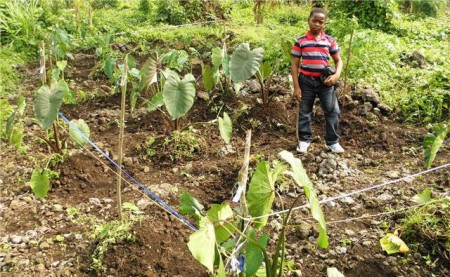- Introducing a New Breed of Wine Yeast: Interspecific Hybridisation between a Commercial Saccharomyces cerevisiae Wine Yeast and Saccharomyces mikatae. The future of wine?
- Breeding systems, hybridization and continuing evolution in Avon Gorge Sorbus. You had me at “Avon Gorge, Bristol, UK, is a world ‘hotspot’ for Sorbus diversity.”
- Taro leaf blight — A threat to global food security. Yes, but we have the technology…
- Agromorphological characterization of Sesamum radiatum (Schum. and Thonn.), a neglected and underutilized species of traditional leafy vegetable of great importance in Benin. Yes, but we need the technology…
- Phenoscope: an automated large-scale phenotyping platform offering high spatial homogeneity. Somebody mention technology?
- An Inventory of Crop Wild Relatives of the United States. More than you’d think.
- Empirical Test of an Agricultural Landscape Model. The Importance of Farmer Preference for Risk Aversion and Crop Complexity. It’s not just about profit. At least in the UK.
- Using citizen scientists to measure an ecosystem service nationwide. Bullshit. No, really, it’s about the decomposition of cow pats.
- Intragenesis and cisgenesis as alternatives to transgenic crop development. Spingenesis.
- Managing biodiversity rich hay meadows in the EU: a comparison of Swedish and Romanian grasslands. Both need more input from local knowledge.
- Mediterranean Hedysarum phylogeny by transferable microsatellites from Medicago. Wait, Sulla? What happened to Hedysarum?
- Polymorphic microsatellite markers in pineapple (Ananas comosus (L.) Merrill). And?
Nibbles: Historical coffee, Conservation agriculture, Ecosystem services, Good weeds
- Kew’s data manglers are breathing life into the archives, but I need more narrative on coffee rust.
- Singing the praises of conservation agriculture in Tanzania.
- IFPRI discovers ecology, and it’s complicated.
- Not to be outdone, CIAT discovers weeds are important food.
Conserving Prunus africana?
I’ve been sitting on it for a while, but a paper which AoB Blog discussed back in January led me to uncover a whole load of stuff on Prunus africana. The African Cherry Tree does not rate a leaflet in the African Food Tree Species series, perhaps because it’s not a, well, food tree, but that doesn’t mean it’s not important.
Chemicals extracted from the tree’s bark are used in a range of pharmaceutical products to treat enlarged prostate (benign prostatic hyperplasia), an extremely common condition that affects up to half of men aged over 50.
Hence various efforts to develop sustainable harvesting methods. And also an interesting series of diversity and demographic studies:
- Phylogeography of the Afromontane Prunus africana reveals a former migration corridor between East and West African highlands: “The high genetic similarity found between western Uganda and west African populations indicates that a former Afromontane migration corridor may have existed through Equatorial Africa.”
- Structural diversity and regeneration of the endangered Prunus africana (Rosaceae) in Zimbabwe: “…poor regeneration, fewer P. africana trees in small and large size classes, dominance of positive height and diameter differentiation and high mingling.”
- Divergent pattern of nuclear genetic diversity across the range of the Afromontane Prunus africana mirrors variable climate of African highlands: “The observed patterns indicate divergent population history across the continent most likely associated to Pleistocene changes in climatic conditions. The high genetic similarity between populations of West Africa with population of East Africa west of the Eastern Rift Valley … provides further evidence for a historical migration route. Contrasting estimates of recent and historical gene flow indicate a shift of the main barrier to gene flow from the Lake Victoria basin to the Eastern Rift Valley…”
- Modelling the potential distribution of endangered Prunus africana (Hook.f.) Kalkm. in East Africa: “Prunus africana distribution is thus highly vulnerable to a warming climate and highlights the fact that both in-situ and ex-situ conservation will be a solution to global warming.”
Maybe we could do with some more seed behaviour data. But it would seem there is now plenty of diversity, demographic and sustainable harvesting information on which to base a comprehensive conservation strategy. Is someone coming up with one?
Pacific taro debuts in West Africa
Readers with a long memory and a thing for root crops may remember our various posts over the past couple of years about an outbreak of Taro Leaf Blight in West Africa, and the promise that resistant varieties from the Pacific may hold for combating the epidemic. Well, our friends at the International Network of Edible Aroids are doing something about it. They’ve just published photos of TLB-resistant varieties from the genebank of the Secretariat of the Pacific Community in Fiji being evaluated in Cameroon. Fingers crossed. And I’m sure collections of the local varieties are being made. Aren’t they?

(Photo by Leke Walter Nkeabeng, Molecular Plant Virus Epidemiologist,
National Scientific Coordinator of Annual Crops, Yaounde, Cameroon,
reproduced by courtesy of the International Network of Edible Aroids)
Nibbles: African food, Cattle grazing, Young farmers, Seed policy, Traditional medicine, Litchis, Land use, Perennial sorghum
- Today’s Nibbles is a Kenya edition. Just because.
- But we’ll start with an African foodie revolution that is passing that country by.
- Cattle need diverse foods too, so don’t neglect those forbs, Kenyans.
- A young Kenyan turns to vegetable growing. Not, alas, of the traditional kind. Yet.
- Well, he better get a move on, because it says here people are after his seeds.
- Seeds are what the traditional medicine industry could do with.
- I guess there’s always litchis.
- Wonder what they’ll do to land use patterns.
- But will there ever be perennial sorghum?